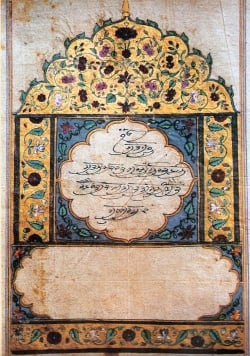Gur Prasaad
| This page contains Gurmukhi script. Without sufficient text support you may see irregular vowel placements and no conjuncts.To enable Punjabi Script and Learn More...] |
Gur Prasaad | ਗਰ ਪਰਸਾਦਿ
By the favour of the Guru
Gur stands for Guru: Master, Spiritual Teacher, Guide. Prasad translates as favour, grace; thus He is attained by the Grace of the Enlightener.
The above translation is that which is given by the majority of Sikhs. Both Macauliffe and Dr.Gopal Singh have suggested that the Mool Mantar was intended as epithets of God - Macauliffe suggest the phrase to mean, "the great and bountiful."
Guru Nanak Dev ji had no human Guru; his Guru was Satgur. Sat(TRUE/TRUTH)gur(In Gurmukhi litteraly meaning IDEA/SOLUTION/KEY to a problem) It was during the spiritual supremacy of his successors the favour of the Guru was invoked, and deemed indispensible for deliverance. Moreover, suggests Macauliffe, though Gur Prasad does sometimes in the Guru Granth Sahib means the Guru's favour, it more often expressed by Guru Parsadi.
Dr.Gopal Singh says that "...many Sikh and European translators have joined the word Gur and Prasad together to suggest: "By favour (or Grace) of the Guru (is He dwelt upon)". But here Guru Nanak is giving, in monosyllables, the attributes of God. The Guru here, therefore, is Guru-in-God whose Grace is invoked. As such Guru can only be rendered as "Enlightener" which is also its literal meaning in Sanskrit."
References
- Macauliffe, M.A (1909). The Sikh Religion: Its Gurus Sacred Writings and Authors. Low Price Publications. ISBN 8175361328.
- Shackle, C (1981). A Guru Nanak Glossary. School of Oriental and African Studies. ISBN 07286002431.
- Singh, Dalip (1999). Sikhism in the Words of the Guru. Lok Sahit Prakashan. ISBN B0000CPD3S.
- Singh, Dr.Gopal (1962). Guru-Granth Sahib Vol.1. Taplinger Publishing Co.. ISBN.
- Singh, Dr.Santokh (1990). English Transliteration and Interpretation of Nitnaym Baanees, Sikh Prayers for English Speaking Sikh Youth. Sikh Resource Centre. ISBN 1895471087.
- Osho (1994). The True Name, Vol.1 : Discourses on Japji Sahib of Guru Nanak Dev. New Age International(P) Ltd. ISBN 8122406068.
- Dr Sahib Singh, D Lit (Jan 1972). Shiri Guru Granth Sahib Darpan. Raj Publishers (Regd),Adda Husharpur Jallundhar. {{{ID}}}.

